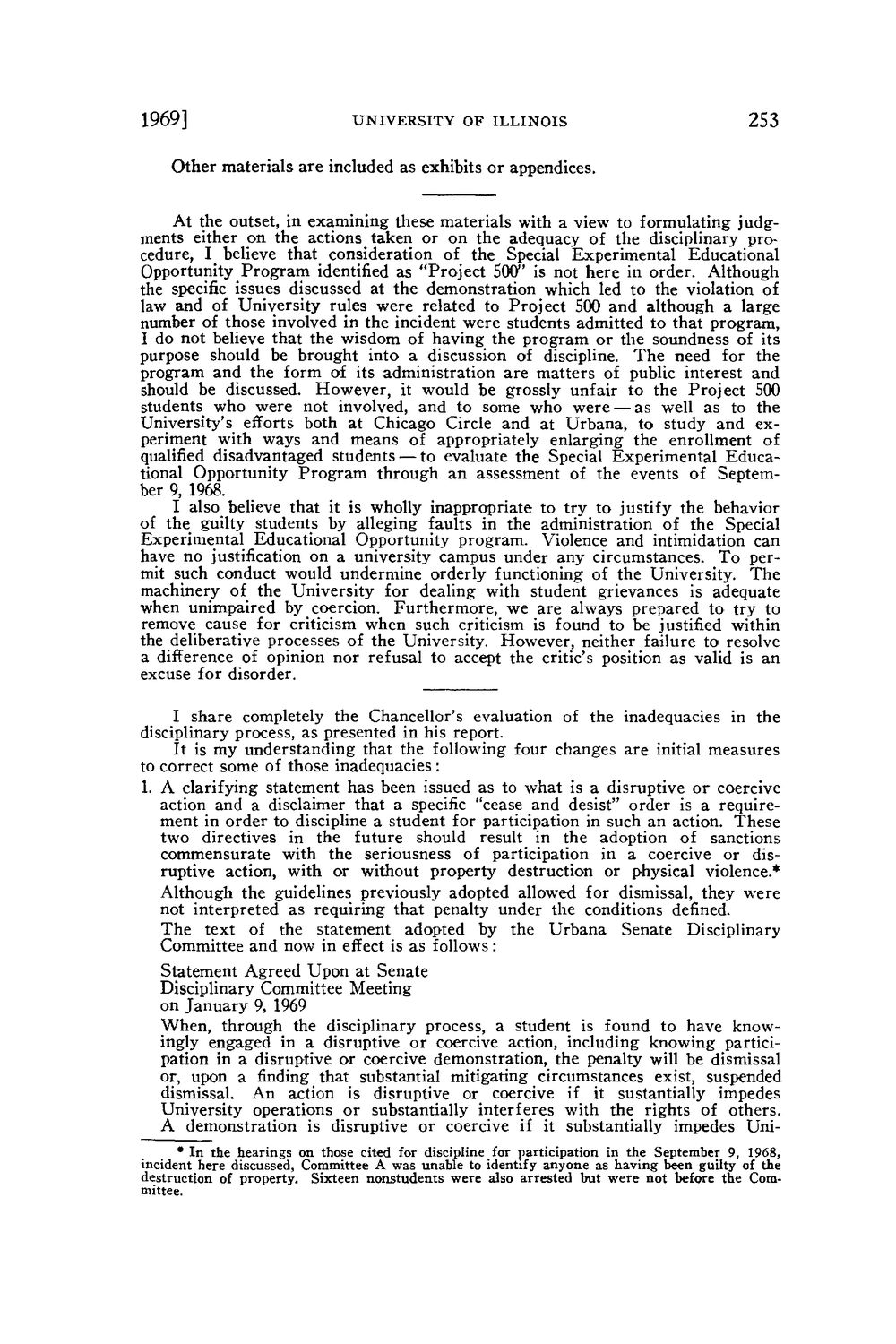| |
| |
Caption: Board of Trustees Minutes - 1970
This is a reduced-resolution page image for fast online browsing.

EXTRACTED TEXT FROM PAGE:
1969] U N I V E R S I T Y OF I L L I N O I S 253 Other materials are included as exhibits or appendices. At the outset, in examining these materials with a view to formulating judgments either on the actions taken or on the adequacy of the disciplinary procedure, I believe that consideration of the Special Experimental Educational Opportunity Program identified as "Project 500" is not here in order. Although the specific issues discussed at the demonstration which led to the violation of law and of University rules were related to Project 500 and although a large number of those involved in the incident were students admitted to that program, I do not believe that the wisdom of having the program or the soundness of its purpose should be brought into a discussion of discipline. T h e need for the program and the form of its administration are matters of public interest and should be discussed. However, it would be grossly unfair to the Project 500 students who were not involved, and to some who were — as well as to the University's efforts both at Chicago Circle and at Urbana, to study and experiment with ways and means of appropriately enlarging the enrollment of qualified disadvantaged students — to evaluate the Special Experimental Educational Opportunity Program through an assessment of the events of September 9, 1968. I also believe that it is wholly inappropriate to try to justify the behavior of the guilty students by alleging faults in the administration of the Special Experimental Educational Opportunity program. Violence and intimidation can have no justification on a university campus under any circumstances. To permit such conduct would undermine orderly functioning of the University. The machinery of the University for dealing with student grievances is adequate when unimpaired by coercion. Furthermore, we are always prepared to try to remove cause for criticism when such criticism is found to be justified within the deliberative processes of the University. However, neither failure to resolve a difference of opinion nor refusal to accept the critic's position as valid is an excuse for disorder. I share completely the Chancellor's evaluation of the inadequacies in the disciplinary process, as presented in his report. It is my understanding that the following four changes are initial measures to correct some of those inadequacies : 1. A clarifying statement has been issued as to what is a disruptive or coercive action and a disclaimer that a specific "cease and desist" order is a requirement in order to discipline a student for participation in such an action. These two directives in the future should result in the adoption of sanctions commensurate with the seriousness of participation in a coercive or disruptive action, with or without property destruction or physical violence.* Although the guidelines previously adopted allowed for dismissal, they were not interpreted as requiring that penalty under the conditions defined. The text of the statement adopted by the Urbana Senate Disciplinary Committee and now in effect is as follows : Statement Agreed Upon at Senate Disciplinary Committee Meeting on January 9, 1969 When, through the disciplinary process, a student is found to have knowingly engaged in a disruptive or coercive action, including knowing participation in a disruptive or coercive demonstration, the penalty will be dismissal or, upon a finding that substantial mitigating circumstances exist, suspended dismissal. An action is disruptive or coercive if it sustantially impedes University operations or substantially interferes with the rights of others. A demonstration is disruptive or coercive if it substantially impedes Uni• In the hearings on those cited for discipline for participation in the September 9, 1968, incident here discussed, Committee A was unable to identify anyone as having been guilty of the destruction of property. Sixteen nonstudents were also arrested but were not before the Committee.
| |